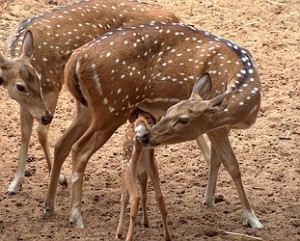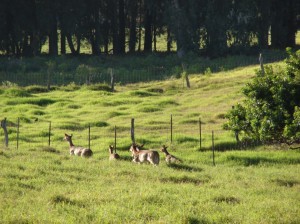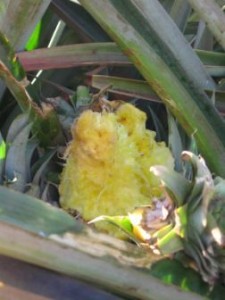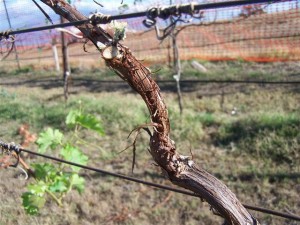Axis Deer Threat on Maui Brings Perspective to Big Island
By Wendy Osher
The state has confirmed the presence of axis deer on parts of the Big Island, a discovery that authorities say poses grave implications to native Hawaiian ecosystems.
Axis deer were first introduced to Moloka‘i and O‘ahu in 1868, Lana‘i in 1920, and Maui in 1959. They were never historically introduced to the island of Hawai‘i, but their newly confirmed presence, experts say, poses a threat to the environmental character of the island.
Axis deer have already caused extensive problems for the agricultural industry in Maui County. The Maui axis deer population has grown six fold over the past 10 years to over 12,000 animals today.
State officials say deer populations have become established in places where they cannot be safely or easily hunted or controlled. On Maui, authorities have seen deer populations move into farmed and urban areas, grazing in herds of hundreds, and causing millions of dollars in damage to farm lands.
The recent sightings on the Big Island were confirmed in Kohala, Ka’u, Kona, and Mauna Kea by crews from the Department of Land and Natural Resources’ Division of Forestry and Wildlife, and a coalition of resource managers on the island.
“We take all of these reports very seriously since there are a number of mammal species present on neighboring islands that could do serious damage to agricultural industry on this island,” said Jan Schipper, program manager with the Big Island Invasive Species Committee (BIISC).
“Ranchers and farmers have already expressed their concerns to me that deer and other species that are suspected to have been illicitly introduced on the Big Island would destroy their crops and possibly introduce new diseases to our island, as has happened on other islands,” he said.
The BIISC is now working with trackers and using game cameras to survey and confirm locations of axis deer across the island. DLNR crews are also expanding surveys and developing a response and removal plan.
Here on Maui, an Axis Deer Working Group was formed between the Maui Invasive Species Committee and the Maui County Farm Bureau. “Based on our own experiences,” said Maui Mayor Alan Arakawa, “we would urge Big Island authorities to act swiftly to eradicate this pest, which has the ability to multiply very quickly, and impact vast areas.”
“We consider this a serious problem with far-reaching economic and environmental impacts to the agriculture industry and native ecosystems on the island,” said William J. Aila, DLNR Chairperson.
Besides agriculture and public safety concerns, conservation agencies are also concerned about the impact to forest and native ecosystems and threatened and endangered species. The existing fences on the Big Island below the 8 foot height needed to keep deer out. State officials say the retrofit of more than 300 miles of fences could cost tens of millions of dollars.
On Maui, the axis deer population compounded the island’s drought problems. “Axis deer definitely compete with livestock for forage, particularly under drought conditions,” said J. Scott Meidell, Vice President and General Manager of Haleakala Ranch Company.
Meidell said the forage tanked in July/August, earlier than expected, as the combination of drought and deer kicked in. “The concentrated damage of deer under those conditions rendered our drought plan useless and caused us significant losses from supplemental feed, destocking, death and premature sales,” said Meidell.
Axis deer, authorities say, can not only cause agricultural losses but can also debark trees, which frequently result in the death of a tree. An estimated 6 productive acres were lost at Tedeschi Vineyards on Maui when deer reportedly ate the crop.
“It is really difficult to put a dollar amount on it since our end product is value added, but we lost about 6 tons of grapes for production which would have amounted to wine revenue of approximately $150,000,” said Paula J. Hegele, President of Tedeschi Vineyards, Ltd.
Authorities at the Maui vineyard plan to put deer fencing around the entire 23 acre property to prevent future losses to next year’s crop.
“Many farmers cannot undertake the high cost of entirely fencing their property to keep out herds of deer, and may literally lose a crop overnight,” said Maui Mayor Alan Arakawa.
“DLNR’s mission is to preserve and protect our natural resources, paramount of which are our watersheds and native ecosystems. We will need to take quick and effective action to prevent costly and destructive impacts on the Big Island that will last for generations, perhaps forever,” said Aila.
Big Island residents, meantime, are being asked to report any sightings of deer or any other unusual new or introduced mammal the the BIISC Hotline at (808) 961-3299.
*** Supporting information courtesy State of Hawaii, Division of Land and Natural Resources.













